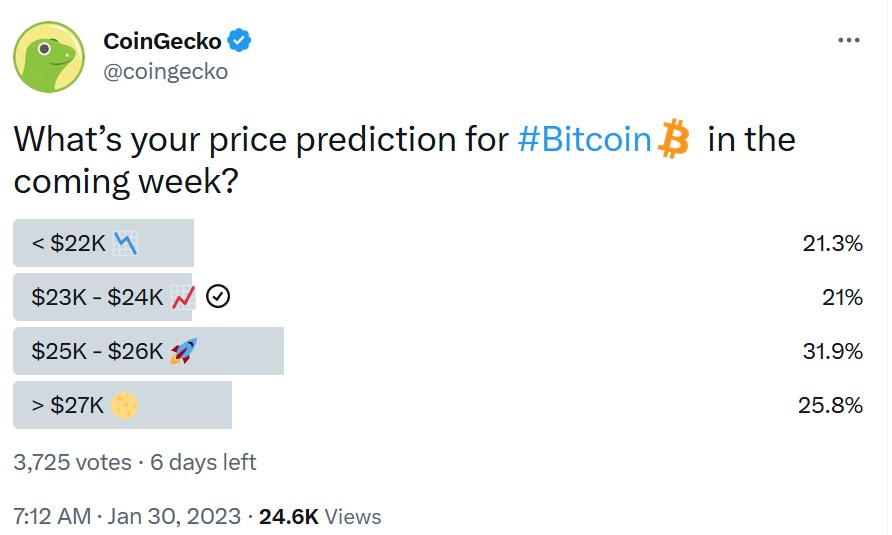
Veteran trader Peter Brandt sparked debate after suggesting BTC may have already hit its peak this cycle, but even he didn’t put much stock in the theory.
There’s a very slight chance that Bitcoin has already reached its peak this cycle at the $70,000 mark, according to the “exponential decay” pattern floated by veteran trader Peter Brandt.
Of course, many other price models and predictors suggest Bitcoin (BTC) is still far from its cycle peak and could instead top out at the $210,000 mark before the end of the bull run.
On April 27, veteran trader and analyst Peter Brandt posted a theory suggesting that Bitcoin’s bull market cycles have exhibited an “exponential decay” pattern.

Currently, a 74% increase takes Bitcoin to over $59,000 and that doesn’t factor in “second-order effects,” says Galaxy Digital.
Bitcoin’s (BTC) price will increase 74.1% in the first year after spot Bitcoin exchange-traded funds (ETFs) are launched in the United States, according to estimates from crypto investment firm Galaxy Digital.
In an Oct. 24 blog post, Galaxy Digital research associate Charles Yu estimated the total addressable market size for Bitcoin ETFs would be $14.4 trillion in the first year after launch. He obtained the 74% figure by assessing the potential price impact of fund inflows to Bitcoin ETF products using gold ETFs as a baseline.
According to Yu’s estimates, Bitcoin’s price would increase 6.2% in the first month after an ETF launch before steadily trending downward to a 3.7% monthly increase by month 12.

Yu used Bitcoin price data from Sept. 30, but a 74.1% increase in Bitcoin’s current price would see it hit $59,200.
Markus Thielen, head of research at digital asset financial services firm Matrixport reached a similar figure in an Oct. 19 post, estimating Bitcoin could rise to between $42,000 and $56,000 if BlackRock’s spot Bitcoin ETF application is approved.
Yu predicts the U.S. Bitcoin ETFs’ addressable market size to reach $26.5 trillion in the second year after launch and $39.6 trillion after the third year.

Related: BlackRock’s Bitcoin ETF: How it works, its benefits and opportunities
Yu acknowledged a delay or denial of spot Bitcoin ETFs would impact its price prediction.
However, he said the estimates were still conservative and didn’t factor in “second-order effects” from a spot Bitcoin ETF approval.
“In the near-term, we expect other global/international markets to follow the U.S. in approving + offering similar Bitcoin ETF offerings to a wider population of investors,” Yu wrote.
He added “2024 could be a big year for Bitcoin” citing ETF inflows, the April 2024 Bitcoin halving and “the possibility that rates have peaked or will peak in the near term.”

Just days after buying $21 million of Coinbase shares, ARK Invest CEO Cathie Wood has added another $19.9 million in Block Inc. shares across its ETFs.
ARK Invest CEO Cathie Wood doesn’t appear to have been swayed by recent crypto regulatory action, buying another $19.9 million shares of Block Inc. right after buying $21 million in Coinbase stock.
Wood’s latest buying spree comes despite the United States Securities and Exchange Commission this week suing two of the industry’s exchange heavyweights, Binance and Coinbase, for offering what the regulator considers to be unregistered securities, among other things.
Coinbase's share price has been depressed in the days following the SEC lawsuit, however, Block Inc.'s shares saw a sharp rise in that same time period.
ARK Invest’s 305,573 new shares of Block came across six buys between June 7-8, which now represents ARK’s fourth largest holding at 4.81%, according to ARK Invest Daily Trades.
Of the new shares, 240,174 were added to its ARK Innovation (ARKK) ETF, 39,099 shares to ARK Next Generation Internet (ARKW) and the remaining 26,300 shares to ARK Fintech Innovation (ARKF).
As for Coinbase, ARK Invest bought 419,324 shares — worth about $21.6 million — across three buys on June 6, which came in the midst of COIN plummeting nearly 20% overnight on June 5.
While many consider the lawsuits to have harmed the crypto firms, Wood recently told Bloomberg that the tougher charges laid against Binance may eventually work in Coinbase’s favor:
“We have Binance under increasing regulatory scrutiny for more criminal activities, fraud being one of them, therefore we have the competition for Coinbase disappearing, so that’s a good thing longer term for Coinbase.”
Coinbase is now ARK Invest’s seventh largest holding at 4.39%, with its total of 11,440 COIN shares spread across its ARKF, ARKK and ARKW ETFs, according to Cathie’s ARK, a website devoted to tracking her portfolio.
Since Q1, ARK Invest has increased the number of COIN shares by 8.2% — which comes on the back of 20.2% and 25.2% increases in Q4 2022 and Q1 this year, according to the website.
Because of regulatory uncertainty, innovation seems to be leaving the US for more friendly regimes. Unfortunate. I believe it will become an election-year issue. https://t.co/PvqK9W27Fd
— Cathie Wood (@CathieDWood) June 4, 2023
While Wood is becoming increasingly bullish on Coinbase, she believes the SEC’s regulation by enforcement approach has taken a toll on cryptocurrency innovators in the U.S.
Related: Bitcoin, Ether are ‘like gold’ says Cathie Wood, but Ray Dalio is skeptical
The tech-savvy CEO is ultra bullish on Bitcoin (BTC) over the long term too.
In the Bloomberg interview, Wood explained that Bitcoin was built to thrive during times of market turbulence and regulatory uncertainty:
“Why would Bitcoin do well in that circumstance? It will do well because it’s an antidote to counterparty risk in the traditional financial system.”
In April 2022, Wood predicted that Bitcoin would reach $1 million by 2030.
Magazine: Hall of Flame: William Clemente III tips Bitcoin will hit six figures toward end of 2024
 Investment management firm Ark Invest has offered three bitcoin price predictions in a new report, including a bull scenario where bitcoin could reach $1.48 million per coin. In other news, a 7zip file possibly linked to activist Julian Assange was reportedly discovered in the Bitcoin blockchain, and billionaire investor Tim Draper has encouraged the government […]
Investment management firm Ark Invest has offered three bitcoin price predictions in a new report, including a bull scenario where bitcoin could reach $1.48 million per coin. In other news, a 7zip file possibly linked to activist Julian Assange was reportedly discovered in the Bitcoin blockchain, and billionaire investor Tim Draper has encouraged the government […]
Bitcoin's huge price surge in January has meant that 64% of Bitcoin investors are in profit, according to data from IntoTheBlock.
Bitcoin (BTC) has just clocked its 11th consecutive day outside the “Fear” zone in the Crypto Fear and Greed Index, cementing its longest streak out of fear since last March.
Bitcoin Fear and Greed Index is 61 - Greed
— Bitcoin Fear and Greed Index (@BitcoinFear) January 30, 2023
Current price: $23,780 pic.twitter.com/U5gxN3AwnT
This comes as Bitcoin hit $23,955 at 8:10 pm UTC time on Jan. 29, its highest level of the year. It has since come back down slightly, to $23,687 at the time of writing.
Meanwhile, Bitcoin sentiment is currently sitting firmly in the “Greed” zone with a score of 61, its highest level since the height of the bull run around Nov. 16, 2021, when its price was about $65,000.

However, despite Bitcoin’s strong resurgence in recent weeks, market participants continue to debate whether the recent price surge is part of a bull trap or whether there is a real chance for a bull run.
Regardless, the current rally has pushed a lot more BTC holders back into the green.
According to data from blockchain intelligence platform IntoTheBlock, 64% of Bitcoin investors are now in profit.
Those who first bought BTC back in 2019 are now — on average — back in profit too, according to on-chain analytics platform Glassnode.
We can calculate the average acquisition price for #Bitcoin by tracking exchange withdrawals.
— glassnode (@glassnode) January 29, 2023
The chart below shows the average withdrawal price for investors for each year.
The average class of 2019+ $BTC is now back in profit (at $21.8k)
Live Chart: https://t.co/yuhvydV70c pic.twitter.com/skjrM6w5lH
The average first-time buy price for BTC investors in 2019 was $21,800, which means those investors are on average up about 9% at the Jan. 29 price of $23,687.
Related: Bitcoin eyes $25K as BTC price nears best weekly close in 5 months
Meanwhile, a Jan. 29 poll from crypto market platform CoinGecko has revealed that 57.7% of 3,725 voters believe BTC will exceed $25,000 this week, while only 21.2% of voters believe BTC is primed for a pullback below $22,000.

The founder and CEO of Vailshire Capital, Dr. Jeff Ross, also provided a technical analysis of his own on Jan. 29, suggesting that a price surge toward $25,000 in the short term may be on the cards:
The strength of #bitcoin on the 4-hour charts continues to be impressive.
— Dr. Jeff Ross (@VailshireCap) January 29, 2023
While price action has trended sideways for over a week, short term indicators (MACD, RSI) have once again reset... and are now ramping higher.
A price surge to ~$25k is probable.
(Not investment advice) pic.twitter.com/QaPbNrxtxZ
Other analysts have called for excited investors to taper some of their expectations, however.
Head analyst Joe Burnett of Bitcoin mining company Blockware told his 43,900 Twitter followers on Jan. 29 that BTC won’t reach and surpass its all-time high of $69,000 until after the next Bitcoin halving event, which is expected to take place in March 2024:
I do not think Bitcoin will make a new all time high until after the 2024 halving.
— Joe Burnett ()³ (@IIICapital) January 29, 2023
Dovish macro conditions and decreased miner sell pressure will lead to the next parabolic bull run.
Using Energy Gravity as a potential top indicator, I expect the next peak to be $150k - $350k. pic.twitter.com/OfCER7s8Zq
Macroeconomist and investment adviser Lyn Alden also recently told Cointelegraph that there may be “considerable danger ahead” with potentially risky liquidity conditions expected to shake the market in the second half of 2023.
 On a few occasions last year, crypto advocates discussed how a number of price models, leveraged to help predict the future value of bitcoin, ended up failing. However, since bitcoin’s value has increased by 36% over the last month, the price has entered the darkest band of the rainbow chart after breaking below the rainbow […]
On a few occasions last year, crypto advocates discussed how a number of price models, leveraged to help predict the future value of bitcoin, ended up failing. However, since bitcoin’s value has increased by 36% over the last month, the price has entered the darkest band of the rainbow chart after breaking below the rainbow […] The U.S. dollar price of ether, which presently hovers around $1,200, is expected to fall to $922.66 by Dec. 10, a Coincodex prediction chart has shown. Ethereum is nonetheless projected to close the following day trading above $1,000. According to the Coincodex analysis, there are presently 15 technical indicators out of a total of 28 […]
The U.S. dollar price of ether, which presently hovers around $1,200, is expected to fall to $922.66 by Dec. 10, a Coincodex prediction chart has shown. Ethereum is nonetheless projected to close the following day trading above $1,000. According to the Coincodex analysis, there are presently 15 technical indicators out of a total of 28 […]
Bitcoin price action since FTX "feels like the world has ended," says Stock-to-Flow creator PlanB.
Bitcoin (BTC) is now further than ever from its target price according to the Stock-to-Flow (S2F) model.
The latest data shows that BTC/USD has deviated from planned price growth to an extent never seen before.
With BTC price suppression ongoing in light of the FTX scandal, an already bearish trend has only strengthened.
This has implications for many core aspects of the Bitcoin network, notably miners, but some of its best-known metrics are also feeling the heat.
Among them is S2F, which is seeing its price forecasts come under increasing strain — and criticism.
Enjoying great popularity until Bitcoin’s last all-time high in November 2021, the model uses block subsidy halving events as the central element in plotting exponential price growth through the years.
S2F allows for significant price deviations and is not “up only” — but even accounting for these, current targets are far higher than spot price.
According to dedicated monitoring resource S2F Multiple, Bitcoin should trade at just over $72,000 on Nov. 19, giving a multiple of -1.47.
On Nov. 10, the multiple reached -1.5 — a record negative reading in S2F’s lifetime — as the FTX impact hit the market.

An alternative iteration of S2F model deviation from analytics platform LookIntoBitcoin produced similar conclusions about this month’s price action.
Related: Bitcoin price may still drop 40% after FTX ‘Lehman moment’ — Analysis
“Price has now strayed further below the S2F line than ever before,” its creator, Philip Swift, wrote in part of an accompanying Twitter post.
“Currently a variance of -1.26 vs. the previous all-time low of -1.21 back in 2011.”

Nonetheless, PlanB, the pseudonymous analyst responsible for the creation — and now, defense — of S2F, remains cool on its utility.
“It feels like the world ended, but FTX will probably be just a small blip on the long term radar,” he argued in his own tweet.
PlanB has fielded increasingly strong accusations over the model in 2022, these including claims that its basis is fraudulent.
In response to the increasing deviation between target and spot price, he maintained that even a comparatively wide range for price to act within and still keep the model valid was still more useful than no insight at all.
The views and opinions expressed here are solely those of the author and do not necessarily reflect the views of Cointelegraph.com. Every investment and trading move involves risk, you should conduct your own research when making a decision.
 In this week’s bite-sized digest of the hottest stories from Bitcoin.com News, a new Finder survey knocks down previous forecasts for ethereum’s price a notch, with crypto experts predicting lower long-term prices for the asset. Also, India calls on G20 nations to bring cryptocurrencies within the “Automatic Exchange of Information” framework, billionaire Thomas Peterffy weighs […]
In this week’s bite-sized digest of the hottest stories from Bitcoin.com News, a new Finder survey knocks down previous forecasts for ethereum’s price a notch, with crypto experts predicting lower long-term prices for the asset. Also, India calls on G20 nations to bring cryptocurrencies within the “Automatic Exchange of Information” framework, billionaire Thomas Peterffy weighs […] Major financial services firm PWC has conducted a study and found that the majority of crypto fund managers surveyed believe that the price of bitcoin would be between $75K and $100K by the end of this year. Bitcoin’s Price Estimate by Crypto Fund Managers PWC, a Big Four accounting firm, published its “4th Annual Global […]
Major financial services firm PWC has conducted a study and found that the majority of crypto fund managers surveyed believe that the price of bitcoin would be between $75K and $100K by the end of this year. Bitcoin’s Price Estimate by Crypto Fund Managers PWC, a Big Four accounting firm, published its “4th Annual Global […]